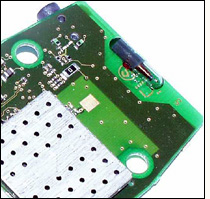Dec 07, 2005Funktel, a manufacturer of telecommunications equipment for internal corporate communications, has been testing a manufacturing process that embeds a small cylindrical RFID tag in each of the printed circuit boards (PCBs) it uses to make its handsets.
The new manufacturing process was developed by German process-automation company CompControl. Using 125 kHz RFID glass-encased tags from Swiss RFID manufacturer Sokymat, as well as and a reader and software developed by CompControl, the system can read the PCB's embedded tag and associate its unique serial number with the other components mounted on that board.
"FunkTel has already manufactured 10,000 RFID-enabled boards, and next year plans for 100,000 more," says Christoph Limpert, a spokesman for CompControl, based in Gersfeld Rhön, Germany.
For each PCB equipped with an RFID tag, Funktel can use RFID to track its manufacturing processes and take inventory of its finished products. Funktel will use the tags as a way to improve product quality control and to enhance customer support. Malfunctioning phones returned by customers can have their RFID tag scanned, and the company will be able to know the components and other details of its production. "This way, if there is a problem with a phone, they can recall any other phones likely to have similar issues," says Limpert. There are also plans for customers to use the phones for applications such as access control, he adds.
The Sokymat tags are encased in glass to provide a hermetic seal, which makes the tags more resistant to damage caused by vibration. The read-only tags carry a 40-bit unique serial number.
According to Sokymat, the RF signals of a tag transmitting at 125 kHz will not interfere with the operation of other components on the board or the functioning of the phone the PCB is in. "Metal environments have almost no influence on the tag reading distance, and no interference with electronic parts on the PCBs," says Egon Konopitzky, vice president of Sokymat.
Putting RFID tags onto printed circuit boards, which are also used in computers and a host of other electrical items, may have enormous potential as a way to provide full product traceability. That lifecycle traceability, says Sokymat, would help manufacturers in the €30 billion worldwide PCB industry meet tougher international regulations regarding traceability, recycling and maintenance of high-value electronic units.


